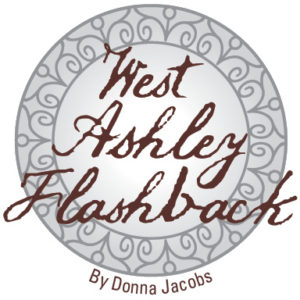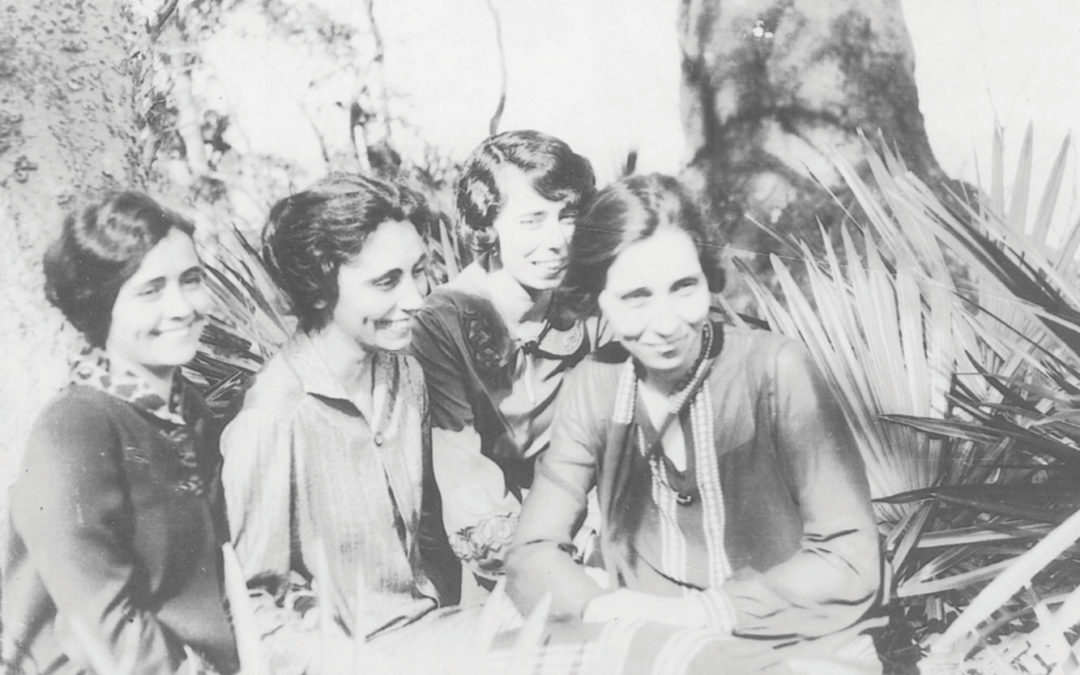Photo: The Santos sister gather at Pleasure Grove. From left to right: Dolly Santos Reynolds, Mamie Santos Harrison (Joe Harrison’s second wife) Inez Santos Grayson and Irene Santos Burk. (Photograph courtesy of Barbara Burk deWitt and Ruth Burk Gay)
 In 1916 Rene Ravenel surveyed a tract of land along the Ashley River known as the “Crafts Tract” for Joe Harrison. Included on the survey were four structures. One of these structures was to become Harrison’s home, but first it would need renovation from its previous use, a dance hall that was built in 1845.
In 1916 Rene Ravenel surveyed a tract of land along the Ashley River known as the “Crafts Tract” for Joe Harrison. Included on the survey were four structures. One of these structures was to become Harrison’s home, but first it would need renovation from its previous use, a dance hall that was built in 1845.
This simple and somewhat fantastic story was shared in two parts. The first was in the form of Ravenel’s plat. The second was an oral and consistent recount from family members. There the story sat in all of its curiosity for many years until digitalization of the News and Courier and The Charleston Evening Post allowed for the fuller story to emerge.
The construction of the “New Bridge” in the late 1880s opened the “picturesque region” on the “other side of the Ashley”. The construction and opening of the “New Bridge” was news and now using key word searches of digital media the early details of this simple story once again could be told.
St. Andrew’s Parish had been connected to peninsular Charleston by a bridge that was burned in 1865 to deter Sherman’s march of destruction into Charleston during the Civil War. It took twenty years before the Charleston Bridge Company would be able to reconnect the two areas.
Numerous articles detailing design and construction ran in the News and Courier during this time period. Once the “graceful structure of the New Bridge” was completed over the ”muddy waters of the historic Ashley” in January of 1886 the public would once again delight in the beauty of the land in St. Andrew’s Parish.
In the June 6, 1887 issue of the News and Courier an ad ran that described “Pleasure Resorts. THE NEW HALL AND GROVE in St. Andrew’s Just Over the Bridge is ALL READY FOR PICNICS. Shady Groves. Good Play Grounds. Excellent Water. All the Conveniences. And the following advantages over places: The Grove and Hall are free. The rates of Toll very little; almost nothing. You can go any time of the day. You can leave at any time. Enterprise Cars carry you to gate of the Bridge at low rate of fare. Special arrangements made with large parties. Parties contemplating giving Picnics would do well to confer with Thomas W. Hughes Keeper at the Bridge.”
This was just one of many ads, that would run for several years, describing Pleasure Grove, the dance hall, and the large cistern with plenty of good water.
Pleasure Grove became a popular destination and many events were documented in the local newspaper. “To spend a day at Pleasure Grove amid the beautiful scenery and shaded by the moss covered and towering oaks is indeed a rare pleasure to picnic parties. After a cool and invigorating walk across the broad waters of the Ashley, at the end of which the pleasure seekers find themselves in a Shady Grove, where a large and commodious Hall is at their disposal.”
In 1889 there was a revival at the hall at Pleasure Grove. June 22, 1892 was the date of the fourth annual picnic of the Jessamine Social Club at the site that was advertised to include a baseball match with prizes. In 1895 the Second Annual Basket Picnic of the Lilac Social Club was held there. In 1896 a bicycle picnic was attended by over 60 “wheelmen and wheelwomen”. In 1906 several churches held picnics.
One of the more interesting and regular events at Pleasure Grove was the tilts of the Charleston Light Dragoons, a prominent militia organization of Charleston’s economic and social elite. (The historic definition of tilt is a joust or combat for sport between two men on horseback with lances).
The tilts were meticulously recorded in journals that are part of the Dragoon’s archives held at the South Carolina Historical Society. There were monthly tilts during the years spanning from 1888 – 1892 with the annual tilt seeing many participants and awards. Some of the awards included silver goblet, monthly medal, basket medal, ladies pin, handicap medal, pair of spurs, and new tilter.
One newspaper account included the following: “ At the close of the tilt for the medals a ‘single dash’ was entered into by all the tilters. The prize, a box of sugar plums, was won by Mr. T.B. Anderson, who, in the management of his charger and in his dexterity in the manipulation of his sabre, certainly deserved both great commendation and the sugar plums.”
Now only one question remains: Who built the dance hall and why?
Stories about Pleasure Groves, tilts for sugar plums, or picnics? Contact Donna at westashleybook@gmail.com.








